You’ve probably heard folks say, “This just needs a little something.” That something? Usually one of the 5 primary taste sensations.
Ever sink your teeth into a dish that just pops with flavor? That’s the magic of knowing how to balance flavors in cooking—getting those five tastes in food (sweet, sour, salty, bitter, and umami) to sing in harmony. I’m Chef Samantha George, a trained culinary professional with over 10 years professional experience in the kitchen and I’m here to share my flavor enhancing techniques—sprinkled with Caribbean flair and hard-earned lessons—to help you make flavorful meals that’ll have your family begging for more.
Ready to enhance food taste and glow up your weeknight dinners? Let’s dive into the five tastes in food and how to cook with balance!
What Are the Five Basic Tastes, Anyway?
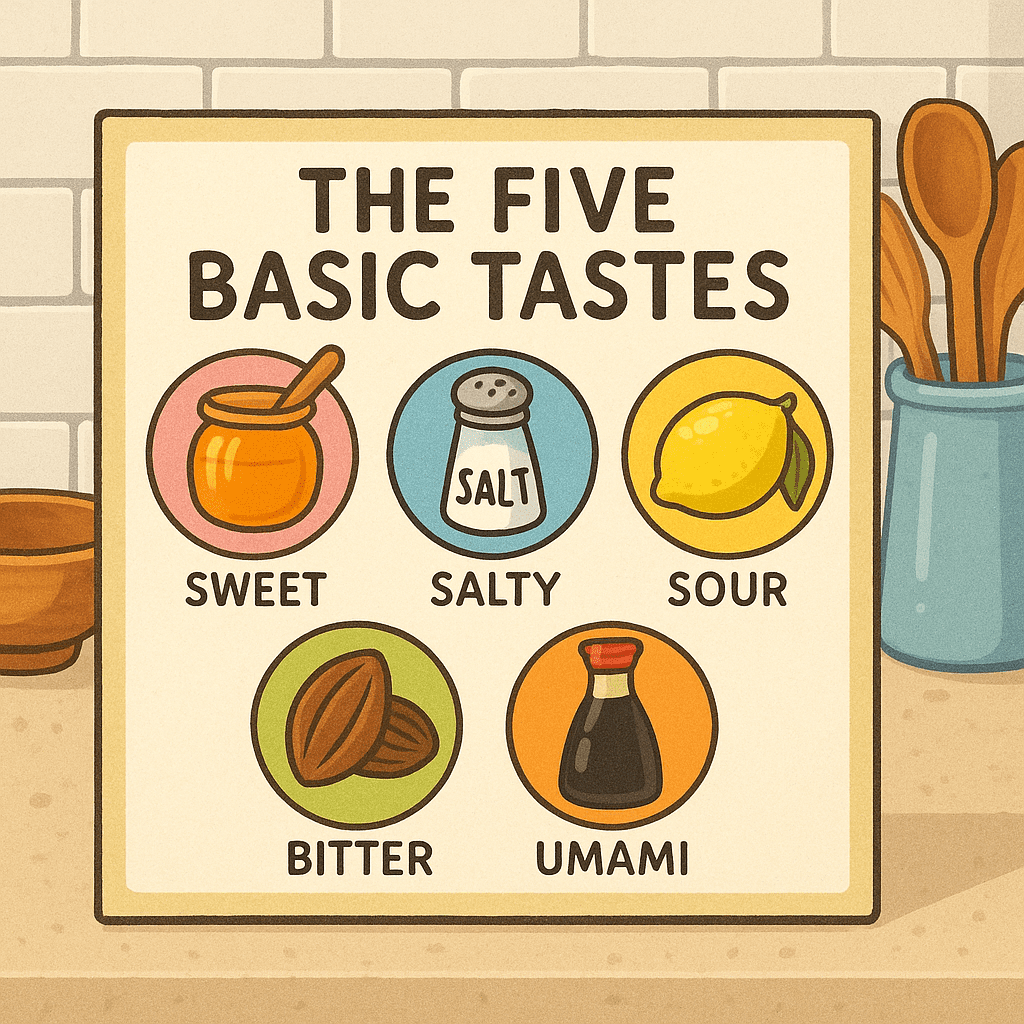
Your tongue’s got five superpowers: it can detect sweet, sour, salty, bitter, and umami. Think of them as the band members of your dish—each needs to play just right for culinary flavor balance. Sweet adds comfort, like a drizzle of Maple Syrup in a glaze. Sour brings brightness, like cooking with Bragg Organic Apple Cider Vinegar and Citrus Squeezer to wake things up. Salty amplifies flavors—think Sea Salt on a juicy steak. Bitter grounds the dish, like charred greens. And umami? That’s the savory depth from Miso Paste or Thai Kitchen Premium Fish Sauce that makes you go, “Whoa, what’s in this?”
I grew up with a mom who intrinsically knew how to balance flavors, but didn’t have the formal training to be able to articulate this. Now that I’ve gone to school and spend the last 18 years learning and practicing my craft, I can say that learning how to define the five tastes was like finding a flavor boosting tip that turned my cooking around. Here’s how you can build flavor in dishes too.
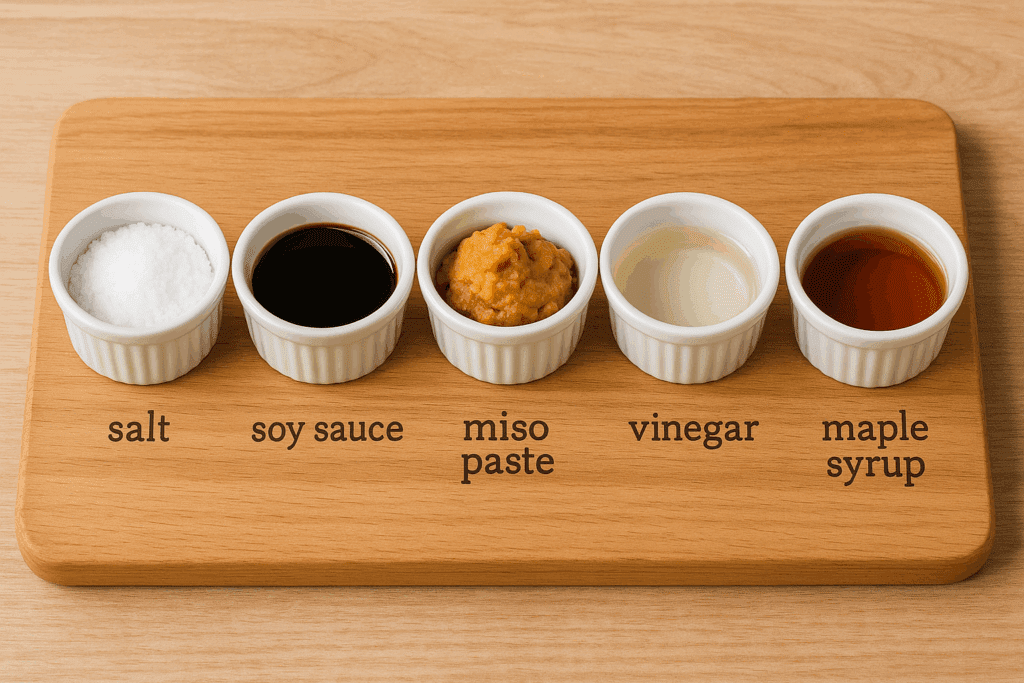
Examples of the Five Tastes
1. Salt: The Flavor Amplifier
Sea Salt’s your kitchen MVP when you know how to use salt in cooking. It’s not about making things “salty”—it’s about enhancing what’s there. I love kosher salt for seasoning chicken or flaky sea salt to finish a dish. But go easy—fixing over seasoned food is tough. I once oversalted a balancing flavors in curry because I was juggling a school pickup call. Never again!
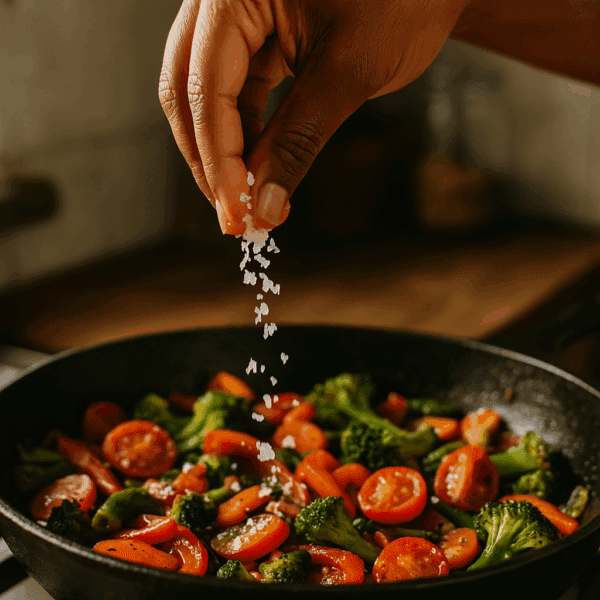
Pro Tip: Salt early to draw out juices from proteins or veggies, and taste while cooking to avoid disasters. If you overdo it, how to reduce saltiness in food? Add a splash of acid in sauces or a pinch of Maple Syrup.
- Salt isn’t just for seasoning—it’s a flavor amplifier.
- Try adding it earlier in the cooking process for deeper penetration.
- Too much? Dilute the dish or add acid, sugar, or fat to rebalance. You might be able to fix over seasoned food
2. Use Sweetness to Round Out Harsh Flavors
- A touch of sugar or Maple Syrup Grade A balances bitter or spicy notes.
- Great for balancing flavors in curry or tomato sauces.
- Yes, even in savory dishes, sweetness in savory food is a thing. I add a very small “toops” (as we stay in Jamaica) of sugar in my stew peas or soups and it makes a major difference.
3. Acid: The Bright Bestie
How to use acid in cooking? It’s your zesty pal that cuts richness and makes flavors pop. Cooking with Bragg Organic Apple Cider Vinegar and Citrus Squeezer, or my favorite, scotch bonnet vinegar, adds acid for brightness in food. I love tamarind paste in stews for a tangy Caribbean twist.
Try This: If your dish feels heavy, you can try a lemon squeeze in savory dishes or a tablespoon of Bragg Organic Apple Cider Vinegar works wonders. I once rescued a bland chili with lemon zest—pure fireworks!
- This is your vinegar, lemon juice, lime zest, tomato.
- To use acid in cooking is about balancing richness. A splash of Apple Cider Vinegar or Balsamic does wonders.
- Acid is perfect for cutting through fat. Think cooking with vinegar and lemon in a heavy monotonous cream based pasta.
4. Bitter: The Unsung Hero
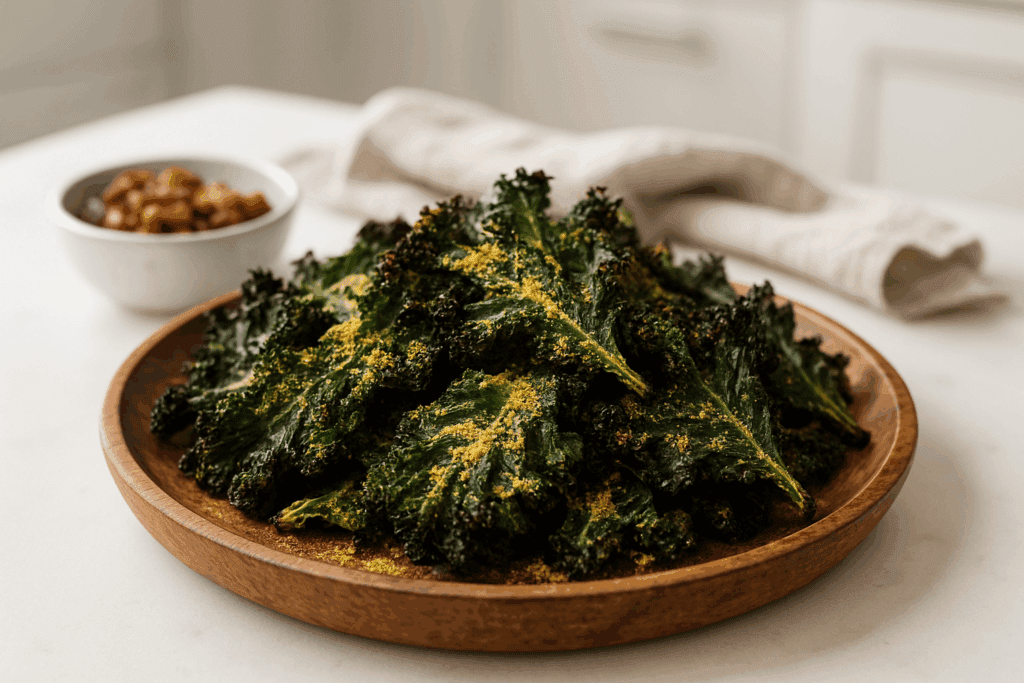
Bitter gets a bad rap, but it’s key for adding flavor depth. Think deeply roasted Brussels sprouts or a hint of coffee in tiramisu. I used to dodge bitter flavors until I tried charred kale with a Miso Paste drizzle—total game-changer. Try Nutritional Yeast Flakes for a vegan-friendly bitter-umami boost.
The key to using bitter well, is to use it quite sparingly as it’s so easy to perceive by the tongue that it can easily overwhelm.
Quick Hack: Common flavor pairing mistakes include ignoring bitter. Balance it with sweetness in savory food or fat. I toss bitter greens with caramelized onions for harmony. Taste test dishes to keep bitter in check.
5. Umami: The Savory Star
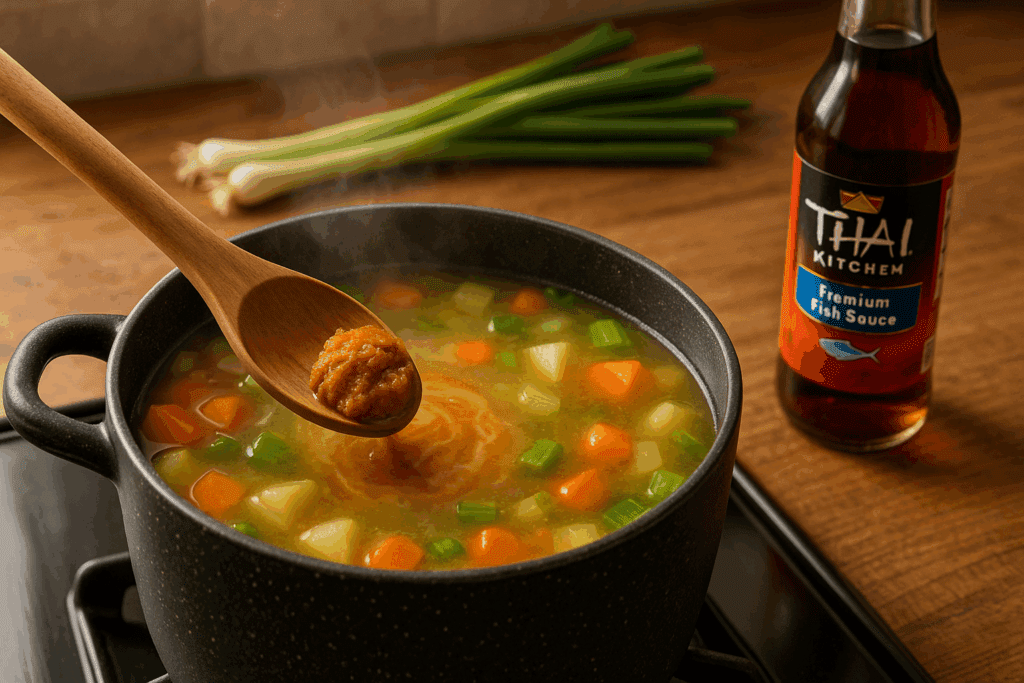
Curious about what is umami flavor? It’s that savory, next-level depth from Kikkoman Soy Sauce, Thai Kitchen Premium Fish Sauce, or Miso Paste. My boys go nuts for my Miso Paste-glazed chicken—it’s umami central. Umami is the fifth basic taste—often described as a deep, savory, mouth-filling flavor—found naturally in foods like mushrooms, aged cheese, soy sauce, tomatoes, and slow-cooked meats.
Easy Win: How to add umami to food? Stir a teaspoon of Miso Paste into soups or stir-fries. I got hooked after a friend’s potluck miso dish. It’s like a warm hug in every bite.
Practicals on How to Balance Flavors in Cooking Like a Pro
- Taste and Adjust Seasoning: Sip, nibble, or dip a spoon into your dish as you cook. How to taste while cooking is key. Too salty? Add acid in sauces. Too sour? Try sweetness in savory food.
- Layer Flavors: Start with salt vs acid cooking, build with layering herbs and spices using a Spice Grinder, then finish a dish with umami or sweet. My jerk marinade’s a vibe—pimento for heat, tamarind for fat acid heat, and Maple Syrup for balance sweet and salty.
- Add Aromatics: Using aromatics to build flavor like onions, garlic, or thyme is my Caribbean secret. They’re the base for what to add to soup for flavor. Use a Scale for precise measurements.
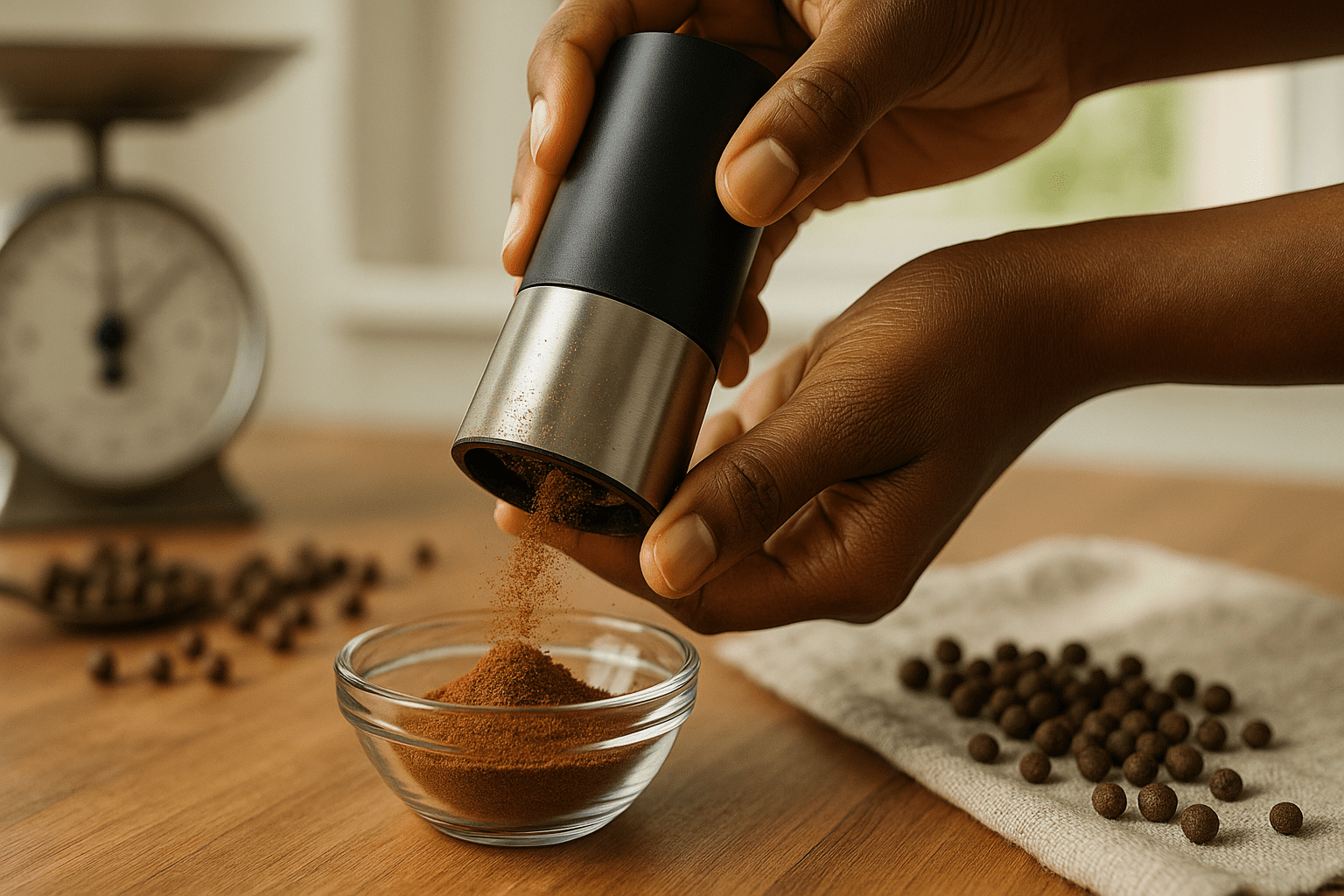
Start practicingg to grind your spices like pimento and black pepper as the pre-ground spices get oxidized quickly
Flavor Balance Chart:
| Taste | Problem | Fix |
| Salty | Too intense | Add acid or sweet |
| Sour | Too puckery | Add fat or sweet |
| Sweet | Too cloying | Add acid or bitter |
| Bitter | Too harsh | Add sweet or fat |
| Umami | Too heavy | Add acid or heat |
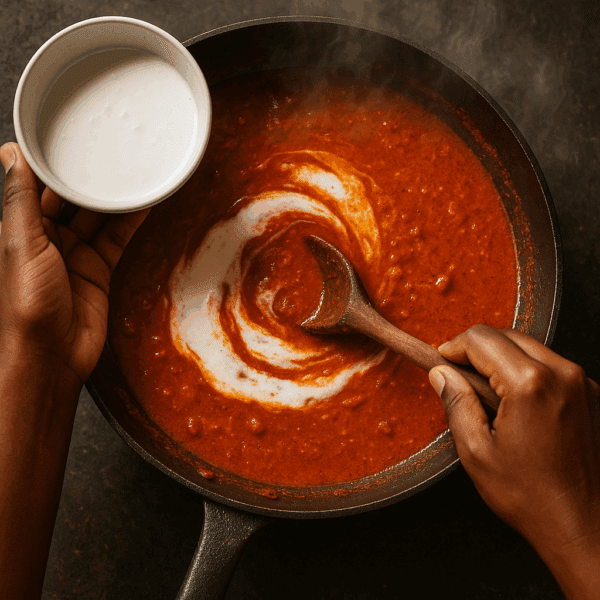
Stir some fat, like coconut milk, into curry to cool down the spice!
Got a fixing overly sweet sauce issue? Add acid for brightness in food. How to fix overly spicy dish? Cool it with sweetness in curry or fat. These cooking flavor hacks are lifesavers.
My Favorite Glow-Up: A Five-Taste Stew

Wanna see how to balance flavors in cooking in action? My Caribbean beef stew’s a winner. It’s got seared beef for umami, scotch bonnet for how to balance spicy food, tamarind for how to cook with acidity, Coconut Milk for fat for flavor in cooking, and Maple Syrup for how to balance sweet and sour. My youngest said, “Mom, this tastes like a restaurant!” I was over the moon.
Here’s the rundown:
- Sear beef in Avocado Oil with kosher salt for that caramelized crust. Check doneness with an Instant-Read Thermometer.
- Add using aromatics to build flavor—onions, garlic, and pimento, ground fresh with a Spice Grinder.
- Stir in Coconut Milk and tamarind paste for creaminess and tang.
- Toss in a pinch of Maple Syrup to balance sweet and salty.
- Finish a dish with fresh thyme and scallions.
Your kitchen’ll smell like a flavor party, perfect for a busy Tuesday.
Real-Life Flavor Fixes (That I’ve Totally Used Myself)
- What to pair with jerk chicken? A spoonful of Coconut Milk in mashed sweet potato to the rescue. That’s how to balance spicy food without crying into your rice.
- Flat-tasting soup? Try more salt or msg and add lots of herbs like thyme, mint, escallion or some heat from peppers. It’s my go-to when folks ask me what to add to soup for flavor.
- Overly sweet glaze? Add an acid or Dijon mustard for balance.
- Tart tomato sauce? Boost with a pinch of sugar, a hint of balsamic, or Miso Paste—yes, even if you think you hate it. You can also neutralize some of the acid with a pinch or two of baking soda.
These are my favorite cooking flavor hacks that save dishes from the compost bin.
Wrapping It Up: Your Flavor Journey Starts Now

Mastering the five tastes in food—sweet, sour, salty, bitter, umami—is like learning a dance. It takes practice, a few stumbles, and tons of heart. I’ve burned sauces, oversalted how to balance tomato sauce, and made a curry so bitter even I couldn’t eat it. But each flop taught me to taste test dishes and tweak. You’ve got this, mama! Start with cooking flavor hacks like a splash of using Citrus Squeezer in savory dishes or a dash of Miso Paste for savory vs umami. Your dinners are about to glow up.
Flavor is personal, but it follows patterns. Start practicing how to cook with balance and soon you’ll know when to reach for salt vs. vinegar, sugar vs. spice. Every pot becomes a little science experiment—with your taste buds as the judge.
My kitchen motto? Don’t just follow the recipe—taste the journey. Keep a spoon handy, stay curious, and let flavor be your guide.
Want more cooking tips or a deep dive into flavor boosting tips? Stick with me. I’ve got plenty more coming to help you build confidence, one spoonful at a time.
If you want to learn more about my essential flavor enhancing techniques, be sure to check out this blog post next: How to Make Food Tasty at Home: 20 Easy Tips for Mouthwatering Meals




